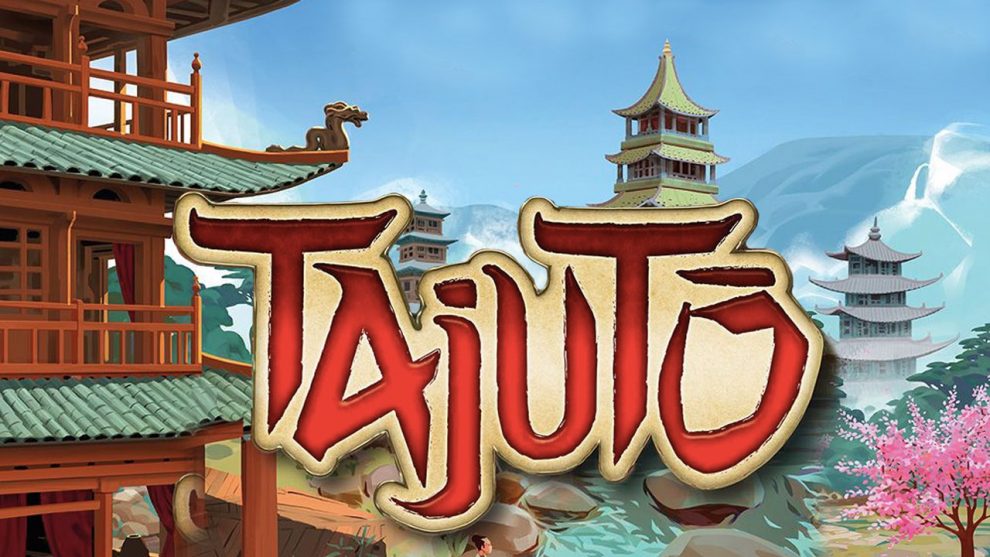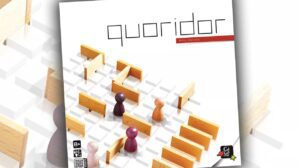Disclosure: Meeple Mountain received a free copy of this product in exchange for an honest, unbiased review. This review is not intended to be an endorsement.
Dr. Reiner Knizia is one of the most prolific board game designers ever. With over 600 published games he is known for his willingness to explore themes ranging from expeditions to watering holes to llamas. Add to that his list of worldwide gaming awards and any new Knizia game should be worthy of attention. Personally, some of my favorite games were designed by him and when I learned of Tajuto I was eager to give it a try.
In Tajuto, you play as a monk who is building Pagodas, floor by floor, and traveling along a Meditation Path to gain the spirituality necessary to win the Prince’s favor and, therefore, the game. During the game you’ll each be adding to the eight Pagodas and making Offerings, trying to outdo your opponents before the fourth Pagoda is completed.
Click below to learn how to play Tajuto. Otherwise, keep scrolling to read my thoughts on the game.
Setting Up the Game
Laying out the tri-fold board you’ll see a thin, blue stream divides the board into two distinctive sections. One side has two sections of outlines for tiles, divided by a numbered Meditation Path; the other has eight color-coded foundation sites for pagodas with a space for a single tile beside it.
Begin by laying out all of the different tiles on the walking path side of the board. The top row is for the Wisdom Tiles, represented by a golden Buddha. Below and to the left are two spaces for the Transcendence Tiles (two Markets and two Shrines). To the right are three spaces for the Additional Action Tiles.
Beneath the Meditation Path are spaces for Objective Tiles.
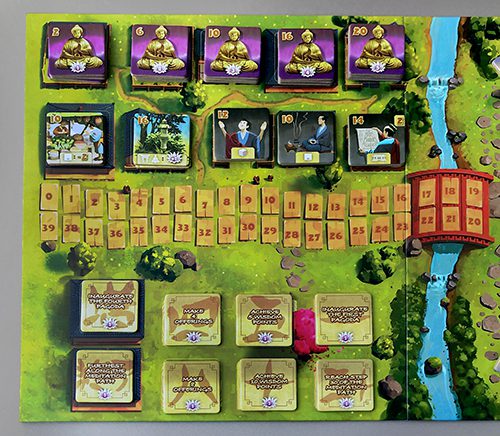
On the Pagodas side of the board, place the tiles of the corresponding color next to each color’s foundation.
Take all 48 of the plastic Pagoda pieces and place them in the Tajuto cloth bag.
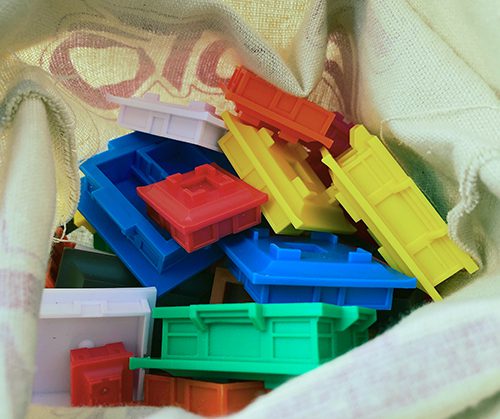
Each player takes a Monk and the set of Action Tiles of a particular color, along with eight colored cubes—one for each of the eight Pagoda colors. (Note, the color you’ve chosen for your Monk has no bearing on which Pagodas you may build.) Place your Monk on Zero on the Meditation Track.
Now you’re ready to play.
Playing the Game
In Tajuto, you will be building Pagodas and making Offerings to move up the Meditation Track. You’ll then move backwards on the track, trading steps in for tiles that grant you Spirituality Points (i.e. victory points) at the end of the game. The player with the highest number of points wins.
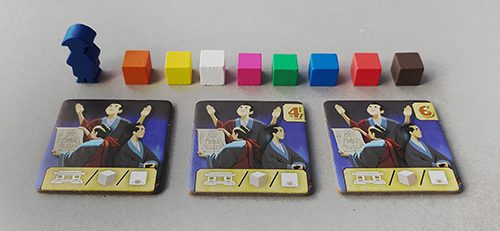
Each player gets three Action Tiles. The one without a number in the upper right corner is a free action and can be used on each turn throughout the game. The others may also be used on a turn as well, but they will cost you either four or six spaces on the Meditation Track to do so.
Each Action Tile allows you to do one of three actions:
- The Pagoda icon indicates you can pull a Pagoda Floor from the bag (without looking!)
- The cube icon shows you can make an Offering at a Pagoda
- The tile icon denotes your ability to trade spaces along the Meditation Path for tiles above the Mediation Path
Let’s look at each one individually:
Pulling from the Bag
Take the Tajuto bag, give it a noisy shake and reach in. Each Pagoda has six separate floors and the upper floors are all identical except for their colors. As you play you’ll get a better feel for which tiles are which size, but in each game I’ve played, we always end up guessing wrong, which is part of the fun. To start, however, you’ll want to feel around for the first level Foundation tiles. These are easy to find because they each have steps along the sides.
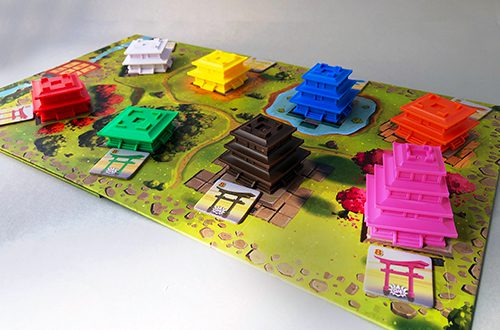
When you place a Pagoda Floor you move up one space on the Meditation Path for the floor you’re placing and one for each floor below. So a Foundation Floor, which is the first level, moves you up one space on the Meditation Path. Placing the third Floor moves you up three spaces, etc.
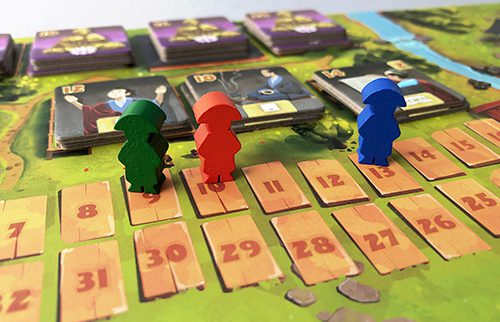
If you pull out a Floor that can be placed on its matching color Pagoda, you must place it.
If you should pull out a Floor that is too small to be placed on its matching color Pagoda, you may either return it to the bag or choose to keep it in front of you. However, whenever that Floor can be played you must play it on your turn.
Making an Offering
Each player has eight wooden cubes, one for each of the eight colors of Pagodas. Instead of pulling a Floor from the bag, you can choose to make an Offering at one of the Pagodas on the board. To do so, you take the matching color cube and place it on the indentation on the top of that Floor.
You advance two spaces up on the Meditation Path for the Offering, as well as one additional space for each Floor of the Pagoda.

Regarding Offerings, it’s important to note that should another player place a Floor that covers your Offering, they will move up two additional spaces on the Meditation Path for doing so. They then advance one space for each Floor as usual.
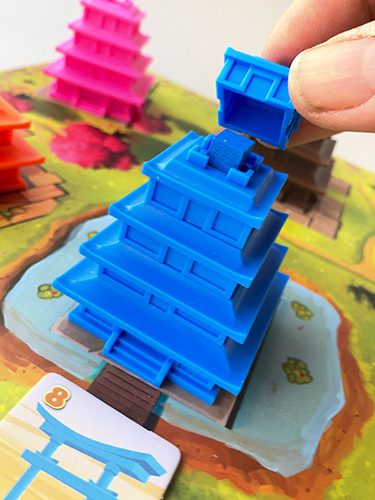
Acquiring Tiles
Your third option is to acquire a tile above the Mediation Path or a Pagoda’s Inauguration tile. You may only trade in up to your current number of spaces on the Meditation Path for these tiles, moving your Monk back down the Meditation Path that number of spaces.
Along the top of the board are the golden Buddha Wisdom Tiles. The number in the upper left corner shows the number of spaces along the Meditation Path you must sacrifice in order to collect the tile. At the bottom center of the tile is the number of Spirituality Points the tile grants you.
Below the Wisdom Tiles are two different types of tiles: Transcendence Tiles and Additional Action Tiles. There are two Transcendence Tiles: one that allows you to give up two fewer steps every time you acquire a tile and one that grants you one additional Spirituality point for every Spirituality Tile you acquire.
To the right of the Transcendence tiles are three Additional Action tiles. The first two allow you to Make an Offering and Acquire a Tile as another Free action. The third allows you to give up two steps on the Meditation Path to draw another Floor from the bag. (The Action Tiles you have in front of you already allow you to do these actions within the same turn. However, they require you to move backwards extra steps to take the additional Action.)
It’s important to note that while there are multiples of each of these tiles, the tiles at the top require fewer moves backward on the Meditation Path to acquire than those further down the stack.

At the base of each Pagoda is an Inauguration Tile in a matching color. Inauguration tiles may only be acquired before a Pagoda is completed and are worth four Spirituality Points if the Pagoda is finished at the end of the game. However, if the game ends and that Pagoda is unfinished, the Inauguration Tile is worth nothing.
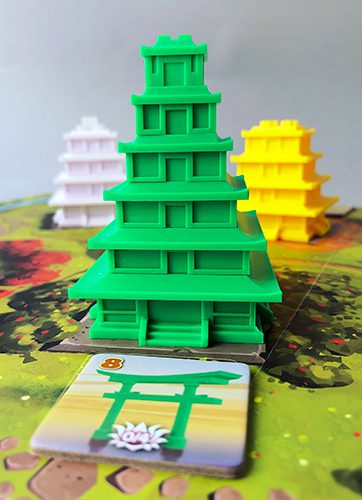
Underneath the Meditation Path there are six Objective Tiles, each worth one Spirituality Point. During the game, players are awarded these as a free action, once the specific objective has been met. These include the first player to achieve five Wisdom points, make four offerings, and Inaugurate the first Pagoda.
The game ends immediately after the fourth Pagoda is completed. The two final Objective Tiles, one for completing the fourth Pagoda and one to the player furthest along the Meditation Path, are given to the appropriate players. Spirituality Points are then tallied up. The player with the most Spirituality is named “The Great Guardian of the Sacred Garden of the Eight Pagodas” by Prince Shotoku and wins the game.
Tajuto: What’s Not to Like?
Tajuto is a visually appealing game. The sturdy cardboard playing board and tiles give players a lot to look at at the start of the game. Then there’s the clank-clank of a full bag of plastic Floor pieces that is sure to grab everyone’s attention.
Explaining the game takes only a few minutes. I’ve found that once players have taken a few turns, they understand enough to ask good, clarifying questions.
Building the Pagodas is both satisfying and fun. All players will be interested in seeing what size and color has been pulled from the bag.
Once Tajuto gets rolling (see below) the push-your-luck element of drawing Floors, balanced by Making Offerings and/or acquiring Wisdom Tiles before your opponents do, makes Tajuto a fun and engaging game.
Once the third and fourth Floors are being placed, the game picks up. You can only make one Offering at each Pagoda so you want to time it to your best advantage. Holding on to a too-small tile can be advantageous as well—placing that Floor and then moving back additional spaces to take a second action to make your Offering can net you additional points, as well as prevent your opponents from making that Offering.
The key to the game appears to be combining moves in a single turn to move you the maximum number of steps up the Meditation Path, and then using those steps to acquire the ‘cheaper’ Wisdom Tiles. Good combinations will net the player Spirituality Points with a minimal loss of spaces on the Meditation Path.
It’s important to remember that moving up the Meditation Path is just a means to an end: acquiring Wisdom Tiles and the Spirituality Points is the way to win the game. Given that Tajuto is a low-scoring game, with average scores in the mid-twenties, players need to stay focused on acquiring them throughout the game.
Tajuto: What’s Not to Like
Tajuto is a slow-moving game to start with. The only action players can take to move up the Meditation Path is to feel in the bag for a Foundation Floor and place it on the board for one point. Even once all eight Foundations are laid, placing a second Floor is only worth two points. Given that the game starts off with the laying out of so many tiles and passing around a bag of noisy plastic pieces, each new group I’ve taught Tajuto to has found the start of their first game to be very anticlimactic.
There are a number of things about Tajuto that just did not sit well with me, starting with the theme. Building Pagodas is all well and good, but using a Meditation Path instead of simply scoring points felt clunky. I would have rather traded points for Wisdom Tiles than sacrificing my progress along a Meditation Path for them—after all, meditation is supposed to lead to Wisdom, but not at the cost of meditative progress. Winning the game by being the Most Spiritual, based on a point structure doesn’t feel right to me either.
Tajuto is not a game for the colorblind or those who are partially colorblind. This bothers me for two reasons: first, it simply wasn’t necessary—a pattern could have been printed on each color’s Floors that allowed for a visual distinction while keeping the Floor pieces tactilely identical.
Secondly, take a look at these Inauguration Tiles.
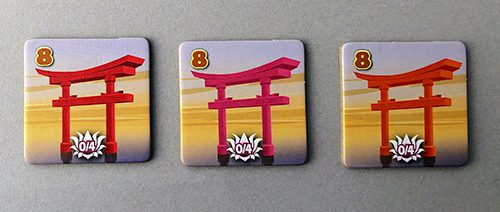
I have never had problems distinguishing colors until Tajuto. Under the incandescent/LED lights of each home I’ve played Tajuto in, every player has had to look carefully at each Inauguration Tile and each Floor piece to make sure they have these three colors correct. In fact, it was only when I went outside to take photographs under natural sunlight for this review that I could easily discriminate between the three colors.
Another annoyance with regard to the pieces: in the first rounds of the game someone will inevitably pull a Foundation Floor that has a Second Floor piece wedged into it. Someone should have caught this during playtesting and had the producers adjust the Floor sizes to avoid this.
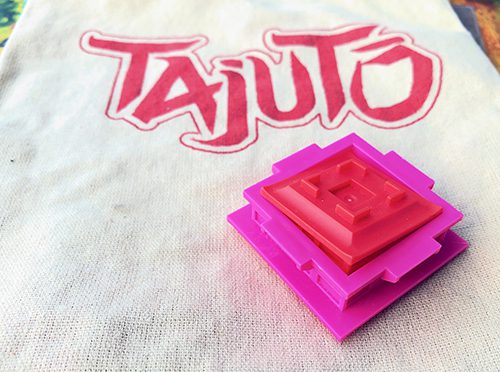
The flavor text that opens the rulebook states that the game takes place in Japan in the year 532. As such, the world of Buddhist Monks and Pagoda builders would have been an exclusively male society. Despite this, I find the decision to create yet another game where there are no women characters to be disappointing. We could have just as easily been building spaceships on launching pads and included female astronauts and engineers.
Finally, there was something about Tajuto that felt broken to me. After thinking about it for the better part of a week and discussing it with one of my weekly gaming partners, I think I know what it is.
Consider these four simple tiles:
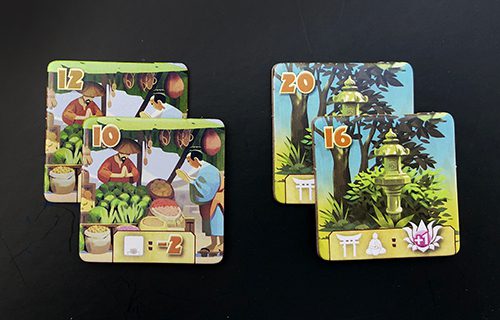
The two on the left allow you to acquire Wisdom Tiles for two fewer steps on the Meditation Track than what the Wisdom Tile indicates. The two on the right grant you +1 Spirituality Point for each Wisdom Tile you have at the end of the game. These extra abilities seem common enough in modern games but in Tajuto—especially when used in combination on turns— they can give players too great of an advantage. For instance, on a turn, a player could use the -2 Transcendence tiles to obtain one of the lower point Meditation Tiles for very few steps on the Meditation Track. The +1 Transcendence Tile means the Meditation Tile will be worth one extra point. This may seem minor, but in such a low scoring game it is not.
In the one game I played where a single player took all four Transcendence Tiles, that person won by a blow-out. That meant that in each subsequent game everyone knew those Tiles were necessary to have a chance at winning. In a two-player game, that could be possible. In a three or four-player game, not so much.
My suggestion: leave them in the box and achieve your Inner Spirituality (points) without them.
Tajuto: To Like or Not Like?
I remain divided on Tajuto. There are elements that I enjoy, there are parts that continue to bother me, and there are things that just don’t work for me at all. I’ve made some compromises: I now call Spirituality Points ‘Victory Points’ and the Meditation Track is simply a scoring track. The pink and orange Pagoda Floors and their matching Inauguration Tiles have been drawn on with permanent markers to subtly differentiate them. The Transcendence Tiles have been banished from the game.
Given the designer and the publisher, as well as the very competitive board game market, I don’t feel that I should have to manually “fix” any part of a game.
The truest test, for me, of any game is whether or not I keep it in my collection. Here, too, I’m willing to make a compromise: Tajuto has found a home with one of my gaming partners who enjoyed the game way more than I did. It will surely be played with his family and friends far more than if it sits on my shelf. And, yes, I’ll be more than willing to play it on game nights if they bring it to the table.


